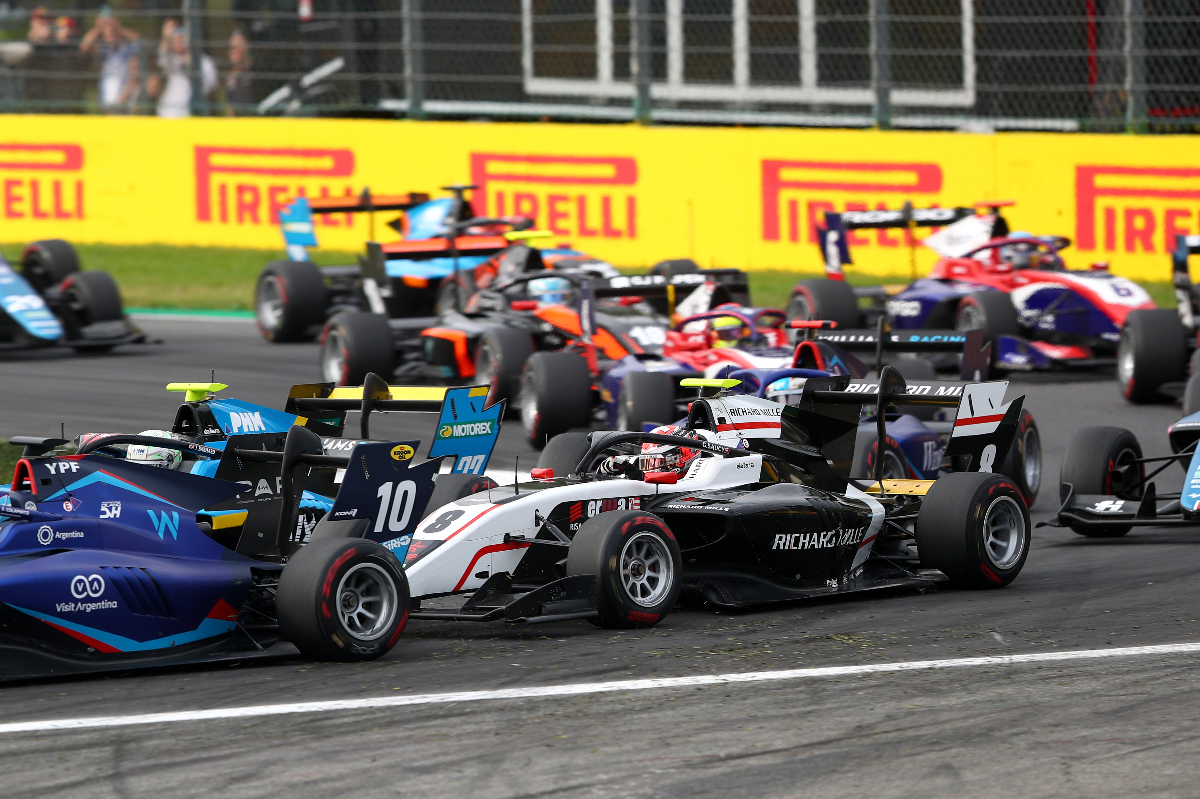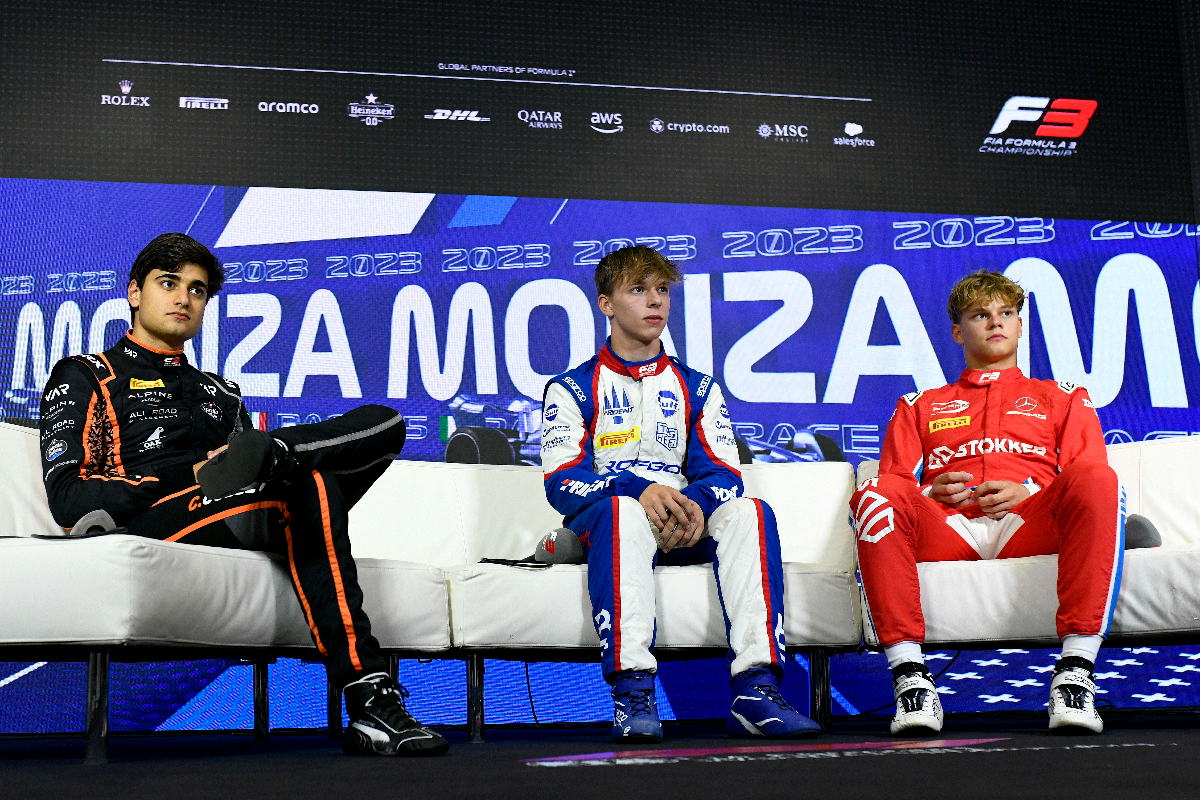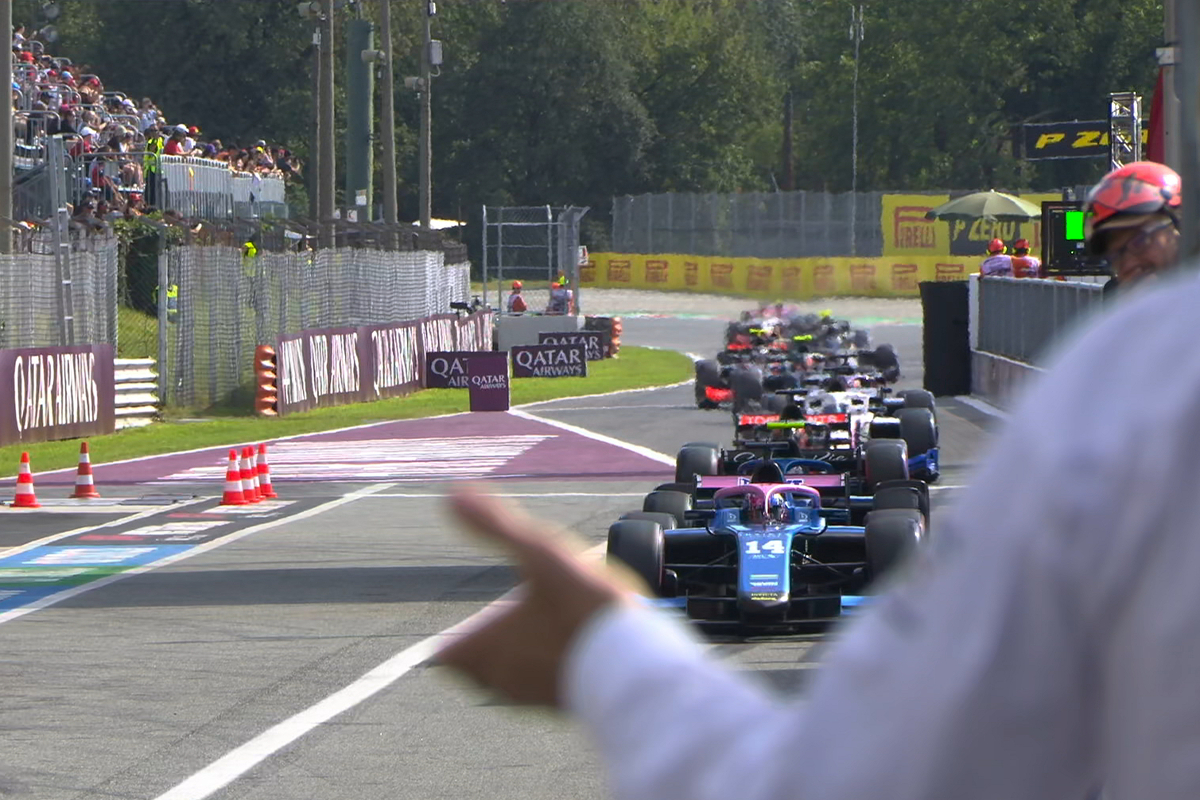
Photos: Formula Motorsport Ltd
Drivers could easily point the finger at each other (and themselves) after F2 and F3 qualifying turned into chaos at Monza, but they seemed less sure about what to do so the same thing doesn’t happen in 2024
The last time Formula 1 raced at Monza with 20 cars was last year, and you have to go back to 2016 to find a grid of 22. There were 24 starting drivers in the 2010, ’11 and ’12 seasons, then if you head all the way back to 1994 you’ll find a grid of 26 cars formed after a qualifying session which featured 28 drivers on track. Three years prior the numbers were even bigger, with 30 names vying to make it onto the 26-car grid.
Now if you remember qualifying for the 1991 Italian Grand Prix, you will recall lots of blue flags, Ayrton Senna getting the 59th pole of his F1 career and Nigel Mansell qualifying a frustrated second after he got held up by traffic on each of his laps. And a bloke called Michael Schumacher, after some legal wrangling, went seventh fastest in his first ever outing for Benetton.
Having 30 cars of massively varying speeds on a 3.6-mile track was clearly too many, but that number was actually reached after a pre-qualifying session. There were 26 drivers guaranteed entry into qualifying, and eight who had to contest pre-qualifying to fight over the four remaining spots. Then once those 30 drivers went into qualifying, which consisted of two sessions lasting an hour each, the four slowest of them would not even get to start the race.
That was 32 years ago, and now F1 not only has a smaller grid but one that is far more closely matched and therefore one driver’s hot lap in qualifying is unlikely to disrupt another’s, which is why the spec series below F1 can have larger grids.
Formula 2 raced at Monza last weekend with 22 cars, and FIA Formula 3 had a capacity grid of 30. Each series was given half an hour for qualifying. Earlier this year F3 got to race on the tight and short Monaco street circuit with its full entry list, as the track’s maximum grid size was unexpectedly raised from 28 cars, but at Spa-Francorchamps (a huge 4.35-mile venue) there were concerns voiced by Mercedes-AMG F1 driver and Grand Prix Drivers’ Association director George Russell.
1st #F1 points for Michael Schumacher
2/306 starts #OTD 🇮🇹 #ItalianGP 1991
👊 #F1FastFact pic.twitter.com/L8QqJNTe3Z
— Formula 1 (@F1) September 8, 2016
“I truly think F3 should not be allowed 30 cars on track at one time at any point, even in dry conditions. I think it’s a matter of time before we have a big accident there, too,” he said.
You can read about how the F3 paddock reacted to those words here, but just one round later there’s renewed focus on the challenges of having a 30-car field due to the absolute chaos that occurred in qualifying at Monza.
There was drama from the off, with cars queuing up on the back straight before a single laptime had been set and red flags being waved after Ido Cohen was spun around by Rodin Carlin team-mate Ollie Gray after slowing to avoid the cars in front of him that were going excessively slowly.
Red flags waved again less than two minutes after the session restarted as Campos Racing’s debuting Joshua Dufek spun into the gravel at the second chicane. Several drivers still had not set a timed lap, and so there was a rush to get just that done when the second restart took place.
Trident’s Oliver Goethe went fastest, then had a huge crash at the second Lesmo and qualifying was stopped – and not restarted – with more than nine minutes left on the clock.
That locked in the top three of Goethe, Caio Collet and Paul Aron, who spoke about the chaotic nature of the session in the press conference afterwards.
“With all the red flags, it was a really difficult session. I think in the end we managed to do only one push lap,” said Van Amersfoort Racing’s Collet. “I think the majority of the grid did only one push lap. But I’m glad that it’s over.”
Goethe “was extremely disappointed in myself” when he crashed, but “I went from extreme sadness to extreme happiness within the space of seconds” once it was confirmed qualifying would not restart.
We have reached peak Formula 3 qualifying in Monza 😬#ItalianGP #F3 pic.twitter.com/lYDSPz4hQZ
— Formula 3 (@Formula3) September 1, 2023
“What do you need to be on pole around the Monza? It seems like this session it was causing a red flag,” joked Prema’s Aron.
“I would have loved to have another run, another go. We haven’t had many rounds with soft tyres with this F3 car, and it’s just super nice to drive around. So I was a bit sad that we didn’t get an opportunity to go out there and push for a few more laps.”
Aside from the damage repair bill, there was no consequences for Goethe from his crash. In other junior single-seater series, rules exist where drivers who cause a red flag stoppage (in practice or qualifying) have their fastest lap up to that point deleted as a puishment. Should FIA F3 do the same?
“I think would be a fair rule. I mean, I think [Oliver] would still qualify the top three, he was really quick today. But I think for the future it’s a fair rule, if you cause a red flag to get your lap time deleted,” said Collet.
The poleman was, somewhat surprisingly, in agreement: “Yeah, that’s understandable. And to be honest, I agree. I think especially in rounds such as Monaco where qualifying is so important and it pretty much decides the weekend. In Monza it’s not as crucial, but even if my lap were to be removed, I’d be towards the top. And I think that would be fair. And in the future it could be an option.”
Aron used the example of the Formula Regional European Championship for how the application of such a rule would not only impact qualifying results, but also approaches.
“Coming from FREC, we had that rule there. If you caused a red flag in qualifying, your best lap was deleted. And it certainly changed the way the drivers approached certain qualifyings,” he explained.
“For example going for the last lap in Monaco, you couldn’t go all out anymore with nothing to lose. If you, for example, did a pole lap one lap before the end and you had that last lap to still really go for it, in FREC you still had to keep that bit of a safety margin because if you caused the red flag and you went in the wall, your pole lap will be taken away.
 “And generally, as we saw this weekend, a red flag can change a lot how the session turns out. So I think it will be a fair rule that if you cause a red flag, your best lap is taken away. But I mean, you can look at it both ways. On the other side as a driver, it’s not easy to think about the fact that if you do a pole lap, you can play that rule to your advantage. So you can look at it both ways. But in fairness, I think it would be more fair to have a rule that if you do a red flag, your lap gets taken away.”
“And generally, as we saw this weekend, a red flag can change a lot how the session turns out. So I think it will be a fair rule that if you cause a red flag, your best lap is taken away. But I mean, you can look at it both ways. On the other side as a driver, it’s not easy to think about the fact that if you do a pole lap, you can play that rule to your advantage. So you can look at it both ways. But in fairness, I think it would be more fair to have a rule that if you do a red flag, your lap gets taken away.”
Given the amount of time left to go after Goethe’s crash, as the session clock gets paused when red flags are waved, it was expected there would be another restart. Formula Scout asked what the drivers made of the decision to end qualifying early.
“I think everybody was surprised. There was so much time on the board still. Everybody put on a new set of slicks. So I think everybody in the pits was ready to go out for another run,” said Aron.
“And suddenly the communication I had with my team was [it was over], we were planning ahead the next run. Because there was 10 minutes to go, and usually a session goes on with that much time. But I guess there was some damage to the barriers and it took them some time to repair it, and in the end there was no time to resume the session. So it was definitely a surprise. And I actually saw the boards of Gabriel [Bortoleto] being champion before I got the message that the session won’t resume. So it was interesting spice, to say the least.”
Collet was also sat “ready to go again” and was “quite surprised” when the red flag panels didn’t return to green. “But in the end, P2 is better than whatever would have come…”
With less cars, more experienced drivers and a more gripped up track, F2 qualifying should have been better than F3’s.
It was not until 12 minutes into the half-hour session that a laptime was set, with drivers even passing through the pits without stopping prior to that [pictured below], but eventually the first runs were completed. When the second runs began, most drivers bunched up and therefore denied themselves the opportunity to improve their pace straight away.
 Campos’s Ralph Boschung found space on his own and went 10th fastest, and even he described that rather sensible tactic to Formula Scout as a “bold strategy”. Prema’s Ollie Bearman, who qualified second, thought getting clean air wouldn’t work.
Campos’s Ralph Boschung found space on his own and went 10th fastest, and even he described that rather sensible tactic to Formula Scout as a “bold strategy”. Prema’s Ollie Bearman, who qualified second, thought getting clean air wouldn’t work.
“You can go without the slipstream, but it’s not going to improve your laptime,” he said. “The first run I was in a good position. For the second run, to improve I need a slipstream. So does everyone else. So we left it to the last moment. Everyone left it to the last moment, and I think it was inevitable when we left the pits with two minutes to go, it was clear that not everyone would make it. And I started my lap kind of half a second behind. So of course I did improve.”
ART Grand Prix’s poleman Theo Pourchaire was frank about the situation, but had no solution to present.
“It’s every year the same thing in Monza. Everyone wants a great slipstream, but we need someone at the front. So that’s it. It’s tough to think about a rule [as a solution] because it’s only specific to that track. Sometimes it’s dangerous. Like the last lap, it was a bit dangerous. Some drivers were going full throttle in the straight, other ones, they were driving really slow. I was also trying to get a great slipstream. I don’t know what we can do to improve, but we need to – I mean the drivers need to be more safe. We try to avoid accidents, but it’s difficult to think about a solution.”
Bearman added that “before we went to start the final lap, there was like ten of us within 100 metres”, but was also “not sure what can be done about that”.
“Everyone needs a slipstream, but no one wants to give it,” he summarised. “In every category that I’ve raced in at this circuit, it’s the same story.”
Trident’s Roman Stanek qualified third and said: “I don’t really think there is a rule for this. Unless they give us the instruction of being two seconds like behind every driver. But in Monza you need a tow. There is no way that you are going to do your best lap without a tow. So yeah, it’s tough to make a strict rule.”
Monza qualifying car count in single-seater series
Eurocup-3 14
F1 Academy 15
FREC 2 groups of 19 (2022 figure)
Formula 1 20
Formula 2 22
FIA Formula 3 30
Italian F4 33
Austrian F3 Cup/F2000 Italian Trophy 39 (2022 figure)
So is there an invetability of such chaos taking place, if it is down to the drivers rather than the rulemakers to determine how navigating the track safely and also being able to go for pole can be juggled?
“Coming into this race weekend, I was expecting exactly this kind of qualifying,” admitted Pourchaire. “Nothing bad happened. We just didn’t do a proper second run for most of the drivers. But that’s part of motorsport.”
Alternatively, Stanek said “it wouldn’t be exciting any more if we don’t have a mess like this”.
That doesn’t sound entirely encouraging for anyone hoping to see a changed approach to Monza qualifying by drivers in 2024.